
Tennis is a racket sport that is played either individually against a single opponent (singles) or between two teams of two players each (doubles). Each player uses a tennis racket that is strung with cord to strike a hollow rubber ball covered with felt over or around a net and into the opponent's court. The object of the game is to manoeuvre the ball in such a way that the opponent is not able to play a valid return. The player who is unable to return the ball validly will not gain a point, while the opposite player will.

Table tennis is a racket sport derived from tennis but distinguished by its playing surface being atop a stationary table, rather than the court on which players stand. Either individually or in teams of two, players take alternating turns returning a light, hollow ball over the table's net onto the opposing half of the court using small rackets until they fail to do so, which results in a point for the opponent. Play is fast, requiring quick reaction and constant attention, and is characterized by an emphasis on spin relative to other ball sports, which can heavily affect the ball's trajectory.

The J-Cart is a special ROM cartridge developed by Codemasters for the Sega Genesis console. It held not only the game data but also came with two additional gamepad ports. This effectively allowed four players to play simultaneously without any extra adapters. The first J-Cart game, Tennis All-Stars, was released in early 1994.
Serve-and-volley is a style of play in tennis where the player serving moves quickly towards the net after hitting a serve, to attempt to hit a volley afterwards. In the serve-and-volley playstyle, the server attempts to hit a volley, as opposed to the baseline game, where the server stays back following the serve and attempts to hit a groundstroke. The serve-and-volley style of play has diminished in recent years with advances in racquet and string technologies which allow players to generate a great amount of top spin on groundstrokes and passing shots. The slowing of court surfaces and deflation of balls, promoting longer rallies for the enjoyment of spectators, has also devalued the serve-and-volley style.

The backhand is a shot used in most racket sports, such as tennis, table tennis and pickleball, where the back of the hand precedes the palm when swinging the racket. Except in the phrase backhand volley, the term refers to a groundstroke. It contrasts with the forehand stroke, where the palm precedes the back of the hand. The term is also used in other sports where a similar motion is employed, such as throwing a sport disc.

A lob in tennis involves hitting the ball high and deep into the opponent's court. It can be used as an offensive or defensive weapon.
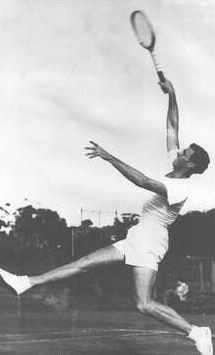
A smash in tennis is a shot that is hit above the hitter's head with a serve-like motion. It is also referred to as an overhead. A smash can usually be hit with a high amount of force and is often a shot that ends the point. Most smashes are hit fairly near the net or in mid-court before the ball bounces, generally against lobs that have not been hit high enough or deep enough by the opponent. A player can also smash a very high ball from the baseline, generally on the bounce, although this is often a less forceful smash.
This page is a glossary of tennis terminology.

Teenage Mutant Ninja Turtles: Tournament Fighters, or Teenage Mutant Hero Turtles: Tournament Fighters in Europe, is the title of three different fighting games based on the Teenage Mutant Ninja Turtles, produced by Konami for the Nintendo Entertainment System, Sega Genesis, and Super NES and released during a period between 1993 and 1994. Konami produced a different fighting game based on the franchise each featuring a differing cast of characters for the platforms. All three versions of the game were re-released as part of Teenage Mutant Ninja Turtles: The Cowabunga Collection in 2022. with online play using rollback netcode for the SNES version of the game.

Sampras Tennis 96 is a 1995 tennis video game for the Sega Genesis developed by Codemasters. It is the sequel to Pete Sampras Tennis. Like its predecessor, it was one of the few titles released on the J-Cart format, which provides two additional controller ports for multiplayer games. The game was followed by Pete Sampras Tennis '97, which was released for the PlayStation and personal computers.

Skitchin' is a 1994 racing video game developed and published by Electronic Arts (EA) for the Sega Genesis. The game puts the player in control of an inline skater who must win races in a tournament while engaging in unarmed and armed combat with other skaters and partaking in skitching, the act of clutching onto a moving vehicle's bumper to gain momentum.

Dream Match Tennis is a 2006 tennis simulation game developed by Bimboosoft, a company based in Saitama, Japan. Unlike other games in its genre, Dream Match Tennis was aimed to produce a more realistic depiction of the sport, requiring more skill from the player in order to direct their shots accurately.
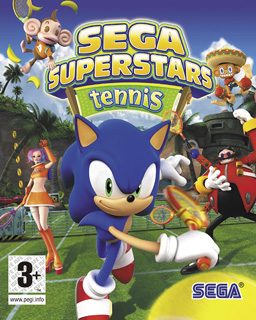
Sega Superstars Tennis is a sports video game developed by Sumo Digital and published by Sega. It is the second title in the Sega All-Stars series, preceded by Sega Superstars (2005), and crosses over characters, locations, and soundtracks from several Sega franchises, including Sonic the Hedgehog, Space Channel 5, and Super Monkey Ball.

David Crane's Amazing Tennis is a tennis simulation video game developed and published by Absolute Entertainment for the Super Nintendo Entertainment System and Sega Genesis consoles in 1992. The game was also made available for the Nintendo Super System. The SNES version got a worldwide release, while the Genesis version only saw a North American release.

A passing shot is a forceful shot, as in tennis or team handball, that travels to one side out of the reach of one's opponent. In tennis, this shot is generally a groundstroke and is used when one's opponent is running to the net or if they are at the net already. The alternative to a passing shot is to lob the ball over the opponent's head. The aim of the passing shot in tennis is to prevent the opponent from returning the ball once he/she is at the net.

ATP Tour Championship Tennis is a tennis video game published by Sega for the Genesis in 1994.
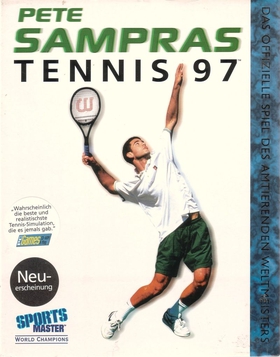
Pete Sampras Tennis '97 is a tennis video game developed and published by Codemasters. It was released for Microsoft Windows and MS-DOS. It was also released for the PlayStation as Sampras Extreme Tennis. It was endorsed by multiple Grand Slam champion Pete Sampras who appears in the game as an unlockable character. It is the third and final game in the Pete Sampras Tennis series, following Pete Sampras Tennis and Sampras Tennis 96.
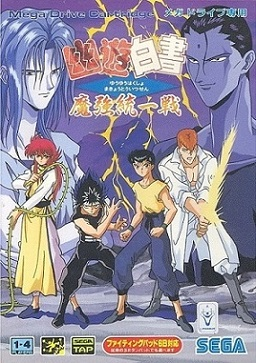
Yu Yu Hakusho Makyō Tōitsusen is a 1994 fighting game developed by Treasure and published by Sega for the Mega Drive. It is based on the manga series Yu Yu Hakusho by Yoshihiro Togashi. The plot follows the protagonist Yusuke Urameshi, who is tasked by the ruler of the afterlife with solving detective-style cases involving both humans and demons threatening the living world. The story begins to focus heavily on martial arts battles as it progresses.

Pelé! is a 1993 sports video game developed by Radical Entertainment and published by Accolade for the Sega Genesis. The game is based on the sport of association football and puts the player in control of a football team in modes of play such as exhibitions, tournaments, and seasons. It is named after and endorsed by former Brazilian footballer Pelé, who also provided input on the game's design.
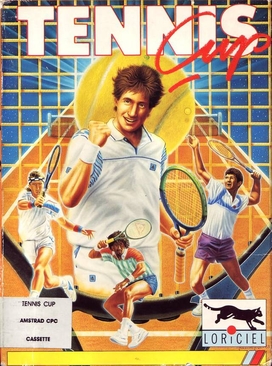
Tennis Cup is a 1990 tennis video game developed and published by Loriciel for the Amiga. It was ported to the Atari ST, MS-DOS and Amstrad CPC during the same year. Tennis Cup was ported to TurboGrafx-16 in 1991 as Davis Cup Tennis. Versions for the Super Nintendo and Mega Drive/Genesis were released in 1993.


















